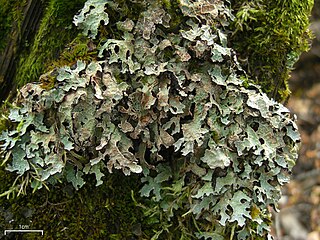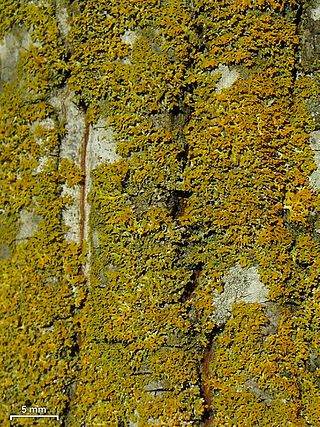Leioderma is a genus of lichen-forming fungi in the family Pannariaceae. The genus was circumscribed by the Finnish lichenologist William Nylander in 1888. He assigned Leioderma pycnophorum as the type species.
Hypotrachyna lueckingii is a species of corticolous (bark-dwelling), foliose lichen in the family Parmeliaceae. It is only known to occur at high elevations on the Cordillera de Talamanca in Costa Rica.

Lichen morphology describes the external appearance and structures of a lichen. These can vary considerably from species to species. Lichen growth forms are used to group lichens by "vegetative" thallus types, and forms of "non-vegetative" reproductive parts. Some lichen thalli have the aspect of leaves ; others cover the substrate like a crust, others such as the genus Ramalina adopt shrubby forms, and there are gelatinous lichens such as the genus Collema.
Punctelia constantimontium is a species of foliose lichen in the family Parmeliaceae. Its range includes South America, Africa, and Mexico, where it grows on bark and twigs.
Atrophysma is a fungal genus in the family Pannariaceae. It contains the single species Atrophysma cyanomelanos, a crustose lichen found only in Alaska.
Fuscidea muskeg is a species of crustose lichen in the family Fuscideaceae. Found in Alaska, it was described as a new species in 2020 by Tor Tønsberg and Martina Zahradníková. The type species was collected in the Hoonah-Angoon Census Area of Glacier Bay National Park. Here it was found growing on a branch of the tree Pinus contorta in muskeg. The specific epithet muskeg is an Algonquin word for a blanket bog.

Parmelia barrenoae is a species of foliose lichen in the large family Parmeliaceae. It was formally described as a new species in 2005. Before this, it was lumped together as one of several lichens in the Parmelia sulcata group—a species complex of genetically distinct lookalikes. Parmelia barrenoae is widely distributed, occurring in Europe, western North America, Africa, and Asia.
Fuscopannaria rugosa is a species of corticolous (bark-dwelling), lichen in the family Pannariaceae. It is found in Hubei and Guanxi in China, where it grows in mountainous forests. Fuscopannaria rugosa is identifiable by its foliose-squamulose thallus, which has longitudinal wrinkles on the upper surface. It also has a distinct hypothallus, a relatively thick algal layer, and a cortex made up of thick-walled cells in both the thalline and apothecial structures. It produces simple, hyaline ascospores that have a smooth, pointed tip at their apex.
Fuscopannaria siamensis is a species of lichen in the family Pannariaceae. It is found in the mountainous forests of northern Thailand and in Tamil Nadu, India, where it grows in humid habitats in association with mosses.

Fuscopannaria leucosticta, commonly known as the rimmed shingle lichen, is a species of lichen in the family Pannariaceae. It has a squamulose (scaley) thallus that lacks soredia and isidia, but has abundant apothecia with distinct white rims. Although its main centres of distribution are eastern North America and southeast Asia, where it grows in damp forests, it has been reported from various other high-altitude, humid locations.
Leptogium compactum is a species of corticolous (bark-dwelling), foliose lichen in the family Collemataceae. Found in northwestern North America, it was formally described as a new species in 2016 by Daphne Stone, Frances Anderson, and James Hinds. It is distinguished from related Leptogium species by the tightly packed hyphae in the medulla; this characteristic internal anatomy is alluded to in the species epithet compactum.
Pannaria minutiphylla is a species of lichen in the family Pannariaceae, described as a new species in 2013 by Arve Elvebakk. The species is similar to Pannaria phyllidiata, but can be distinguished by its smaller phyllidia and ascospores that are elongated to ellipsoid.
Pannaria emodii is a species of corticolous (bark-dwelling), squamulose (scaley) to foliose (leafy) lichen in the family Pannariaceae. It was formally described as a new species in 2001 by the Norwegian lichenologist Per Magnus Jørgensen. The type specimen was collected in 1967 by Hiroshi Harada and colleagues from Shodu-Barshong (Bhutan) at an altitude between 3,500 and 3,800 m.
Leptogium cookii is a species of corticolous (bark-dwelling), foliose lichen in the family Collemataceae. It is found in northwestern North America.
Erioderma borbonicum is a little-known species of corticolous (bark-dwelling), foliose lichen in the family Pannariaceae. It is endemic to Réunion, an island in the Indian Ocean. The lichen forms a dense, cushion-like thallus with a diameter of 3 to 4 cm, with flat, slightly overlapping lobes with a grey-brown upper surface and cream-coloured underside.

Gallowayella weberi is a species of corticolous and saxicolous, foliose lichen in the family Teloschistaceae. Found in the eastern United States, it is a small lichen with a smooth yellow to orange upper surface and a contrasting white lower surface.
Gallowayella galericulata is a species of corticolous and lignicolous lichen in the family Teloschistaceae. This species has small, orange, foliose (leafy), loosely adnate thalli that form either compact colonies or spread extensively. The lobes of the thallus are typically curved inward, and often form a characteristic helmet- or hood-like shape. Found in dry regions of the western United States, it colonises bark and wood, particularly favouring dry twigs of various shrubs and trees.
Awasthia is a monotypic fungal genus in the family Physciaceae. It contains the single species Awasthia melanotricha, a foliose lichen found in the Nepal Himalayas.
Lepraria torii is a species of corticolous and lignicolous, leprose lichen in the family Stereocaulaceae. It is found in northwestern North America.

Tuckermannopsis orbata, commonly known as the variable wrinkle lichen, is a species of foliose lichen in the family Parmeliaceae. It is a small cetrarioid lichen, an informal growth form category that denotes lichens with erect, foliose thalli, and apothecia and pycnidia on the margins of the ruffled lobes. Tuckermannopsis orbata is found in Asia and North America, growing primarily on the wood and bark of mostly birch and coniferous tree branches and twigs.





